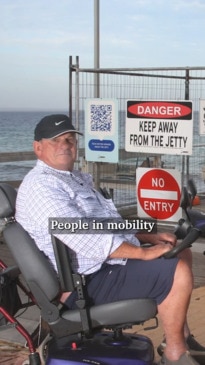Save South Australia’s neglected jetties | Peter Goers
Everyone loves South Australia’s jetties and yet they’re left to be demolished by sheer neglect, writes Peter Goers.

Opinion
Don't miss out on the headlines from Opinion. Followed categories will be added to My News.
My jetty jumping days are over.
Actually, they never began although as a kid I loved jumping off the Port Vincent Wharf especially to bomb deluxe yachts moored there from the Royal Yacht Squadron and the champagne-quaffing yachties aboard.
Metaphorically, I’ve spent a lifetime doing that.
On my first day as a swimming teacher, I almost lost an entire class of beginners to a rip under the Grange Jetty. Oops.
I rarely walk the length of my local Glenelg Jetty because I’m desperately trying to get my steps down and cannot beat my record of 36 steps in one day.
I love jetties.
We all love jetties on which to promenade, take the sea air, watch other people, fish, net a crab, jag a squid, distribute the ashes of a loved one and even jump off and swim.
People canoodle and even conceive babies under jetties.

While we still have many commercial jetties most recreational jetties are happy remnants of the era before the proliferation of roads when maritime transport was crucial.
Many of the more than 100 SA jetties are doomed without co-operative funding from state and local government.
The maintenance, restoration and even replacement of jetties has become a buck passing operation.
Many jetties are owned by the State Government and leased to councils.
The councils blame the government for lack of funds and the government blames the councils while creaky old jetties fall apart.
This is demolition by neglect.
The cheery and charming town of Tumby Bay had its beloved jetty closed two years ago and the town suffers.
Jetties are remarkably and durably engineered, yet precarious to the extreme elements. They are quaint, characterful and essential.
They let us all walk on water.
Most of our jetties are in regional South Australia and our regions are so often neglected by city politicians. Jetties are caught in the city/country divide.
But jetties are crucial infrastructure.
The Holdfast Bay Council is about to raise rates to spend $30m tarting up Jetty Road, Glenelg, but resists funding the repair or replacement of the Glenelg Jetty, SA’s best known and most popular jetty. If that jetty falls into the sea (as it did in 1948), Jetty Road, Glenelg, will be renamed No Jetty Road, Glenelg.
The Holdfast Bay Council leases the jetty from the State Government which has other priorities such as funding the extremely wealthy AFL.
I’m indebted to jetty historian Neville Collins and in his definitive “Jetties Of South Australia” we learn that there are long jetties, particularly that which is germaine to Port Germein, 1.66km; short jetties, Thistle Island, 7 metres; and silly jetties, Normanville Jetty barely reaches the water at low tide.
The Glenelg Jetty is comparatively new. Premier Don Dunstan drove the first pile (which sounds rather rude) in 1969 and the late Queen Elizabeth II and Prince Philip (later Sir Prince Philip) failed to disembark from the Royal Barge on to the Glenelg Jetty in a storm in 1986.
We even had a faux jetty going nowhere at Elder Park for a festival.
New jetties are occasionally built – Rapid Bay and the new Whyalla Jetty which is a triumph and a great asset.
How many jetties are heritage listed? Not that that helps.
The venerable and much-loved Granite Island Causeway was de-heritage listed so that an ugly, charmless, concrete highway could be built in its place.
Save our jetties.
Tolls are impractical but our jetties need political will and funds to be restored, and celebrated as piers without peer.





